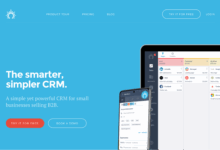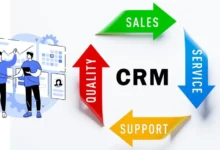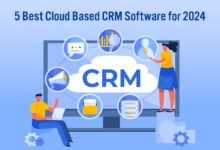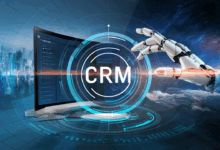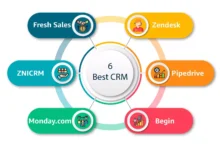Best CRM for Financial Services
Best CRM for Financial Services is crucial for financial institutions navigating the complexities of modern client management and regulatory compliance. This exploration delves into the selection process, highlighting key features, integration capabilities, and the overall return on investment. We’ll examine various leading CRM platforms, comparing their strengths and weaknesses to help financial professionals make informed decisions.
The financial services industry demands robust CRM solutions capable of handling sensitive data, adhering to strict regulations, and providing insightful analytics. This guide aims to provide a comprehensive overview, covering everything from defining specific needs to assessing long-term scalability and future-proofing strategies. We’ll analyze cost considerations, user experience, and the importance of seamless integration with existing financial systems.
Defining Needs in Financial Services CRM
Selecting the right CRM for a financial services organization requires careful consideration of the unique operational needs and regulatory landscape. Different sectors within financial services have distinct requirements, demanding a CRM solution tailored to their specific workflows and data management needs. This necessitates a thorough understanding of the key features and functionalities required for optimal performance and regulatory compliance.
The diverse nature of financial services necessitates a nuanced approach to CRM implementation. A one-size-fits-all solution is unlikely to be effective across the various sectors. For example, a wealth management firm’s CRM needs will differ significantly from those of an insurance company or a retail bank.
CRM Requirements Across Financial Services Sectors
The specific needs of a CRM vary considerably depending on the sector. Here’s a breakdown of the unique requirements for different financial service sectors:
- Wealth Management: Wealth management firms require CRMs with robust client relationship management capabilities, sophisticated portfolio tracking features, and tools for managing complex financial products and services. These systems often integrate with external investment platforms and reporting tools to provide a holistic view of client assets and performance. Advanced analytics are crucial for identifying high-value clients and tailoring investment strategies.
- Insurance: Insurance companies need CRMs that manage policy information, track claims, and facilitate communication with clients and agents. Integration with policy administration systems is vital. Features for managing complex insurance products, handling renewals, and complying with specific insurance regulations are essential.
- Banking: Retail banking CRMs often focus on customer service and account management. These systems need to handle large volumes of transactions, manage customer inquiries, and provide a seamless omnichannel experience. Integration with core banking systems is crucial for accurate data synchronization and reporting. Features for fraud detection and risk management are also essential.
Regulatory Compliance in Financial Services CRM
Regulatory compliance is paramount in the financial services industry. A CRM solution must incorporate features that ensure adherence to various regulations, including data privacy laws (like GDPR and CCPA), anti-money laundering (AML) regulations, and Know Your Customer (KYC) guidelines. Failure to comply can result in significant penalties and reputational damage.
Crucial features include:
- Data encryption and security: Protecting sensitive client data is critical. Robust security measures are essential to prevent unauthorized access and data breaches.
- Audit trails: Maintaining detailed records of all CRM activities allows for easy tracking and verification of compliance with regulatory requirements.
- Access controls: Implementing role-based access controls ensures that only authorized personnel can access sensitive client information.
- Data retention policies: The CRM must comply with data retention regulations, ensuring that data is stored and disposed of appropriately.
Key Performance Indicators (KPIs) for Financial Services CRM
Measuring the success of a financial services CRM requires the use of relevant KPIs. These metrics provide insights into the effectiveness of the CRM in achieving business objectives and improving operational efficiency.
- Customer Acquisition Cost (CAC): Tracks the cost of acquiring a new customer through CRM-related activities.
- Customer Lifetime Value (CLTV): Measures the total revenue generated by a customer over their relationship with the financial institution.
- Customer Satisfaction (CSAT): Assesses customer satisfaction with the services provided through the CRM.
- Net Promoter Score (NPS): Measures customer loyalty and willingness to recommend the financial institution’s services.
- Sales Conversion Rate: Tracks the percentage of leads that convert into paying customers.
- Average Revenue Per User (ARPU): Measures the average revenue generated per customer.
- First Response Time: Measures the speed of responding to customer inquiries through the CRM.
- Resolution Time: Measures the time it takes to resolve customer issues.
Feature Comparison of Top CRM Platforms
Choosing the right CRM for a financial institution requires careful consideration of various factors. This section compares the core features of three leading CRM platforms frequently used in the financial services sector: Salesforce Financial Services Cloud, Microsoft Dynamics 365 for Finance, and HubSpot CRM. We’ll analyze their strengths and weaknesses across key areas to aid in your selection process.
Feature Comparison Table
The following table summarizes key features, pricing models, and integration capabilities of the three chosen CRM platforms. Note that pricing can vary significantly based on the number of users, required features, and specific customizations.
| Vendor | Key Features | Pricing Model | Integrations |
|---|---|---|---|
| Salesforce Financial Services Cloud | Client 360 view, wealth management tools, regulatory compliance features, personalized client portals, robust reporting and analytics, KYC/AML capabilities. | Subscription-based, tiered pricing depending on features and user count. Often requires professional services for implementation. | Integrates with various financial applications, data analytics platforms, and other Salesforce products. Extensive AppExchange ecosystem for further integration options. |
| Microsoft Dynamics 365 for Finance | Comprehensive financial management capabilities, integrated CRM functionality, robust reporting and analytics, strong security features, supports various financial instruments and processes. | Subscription-based, tiered pricing. Pricing depends on modules selected and user count. | Integrates with other Microsoft products (e.g., Office 365, Power BI), as well as various third-party financial applications. |
| HubSpot CRM | Strong contact management, sales automation features, marketing automation capabilities, free basic plan available, good for smaller financial institutions or specific teams. | Freemium model; offers a free plan with limited features and paid plans for enhanced functionality and user capacity. | Integrates with a wide range of marketing and sales tools; offers an app marketplace for additional integrations. |
Cloud-Based vs. On-Premise CRM Solutions
Cloud-based CRM solutions offer scalability, accessibility, and reduced IT infrastructure costs. They are easier to implement and maintain, and updates are handled automatically by the vendor. However, they rely on a stable internet connection and data security depends entirely on the vendor’s infrastructure and security measures. On-premise solutions offer greater control over data security and customization but require significant upfront investment in hardware, software, and IT personnel for maintenance and updates. The choice depends on the institution’s size, IT capabilities, and risk tolerance. Larger institutions with stringent regulatory requirements might prefer on-premise solutions for greater control, while smaller firms may find cloud-based solutions more cost-effective and manageable.
Security and Data Privacy Features
Data security and privacy are paramount in financial services. All three platforms discussed offer various security features, including data encryption, access controls, and audit trails. Salesforce and Microsoft Dynamics 365, being enterprise-grade solutions, typically offer more sophisticated security features and compliance certifications (like SOC 2, ISO 27001) compared to HubSpot. However, all vendors regularly update their security protocols to address evolving threats. It’s crucial to thoroughly review each vendor’s security documentation and compliance certifications to ensure they meet the specific regulatory requirements and security standards of the financial institution. For example, compliance with regulations like GDPR and CCPA is crucial for institutions handling European or Californian customer data.
Integration Capabilities and Data Management
In the dynamic landscape of financial services, a robust CRM’s ability to seamlessly integrate with existing systems and effectively manage data is paramount. Efficient data flow and comprehensive reporting are crucial for optimizing operations, enhancing client relationships, and maintaining regulatory compliance. A well-integrated CRM acts as the central hub, consolidating information from disparate sources and providing a unified view of the customer.
The importance of seamless integration with existing financial systems, such as accounting software, payment gateways, and loan origination platforms, cannot be overstated. These integrations eliminate data silos, reduce manual data entry, and minimize the risk of errors. Real-time data synchronization ensures that all departments work with the most up-to-date information, leading to improved decision-making and enhanced operational efficiency. For instance, integrating a CRM with an accounting system allows for immediate updates on client balances and transaction history, providing a holistic view of the client’s financial profile. Similarly, integration with a payment gateway streamlines the billing and payment process, reducing delays and improving customer satisfaction.
Improved Data Management and Reporting
A CRM significantly enhances data management and reporting capabilities within a financial services firm. By centralizing client information, a CRM provides a single source of truth, eliminating inconsistencies and redundancies across different departments. This improved data quality allows for more accurate analysis and reporting, enabling financial institutions to gain valuable insights into customer behavior, identify trends, and make data-driven decisions. Advanced CRM systems offer features like data cleansing, deduplication, and automated reporting, further improving efficiency and accuracy. For example, a financial advisor can use CRM-generated reports to track client portfolio performance, identify high-net-worth individuals, or analyze the effectiveness of different marketing campaigns. This data-driven approach leads to better resource allocation and improved business outcomes.
Data Flow Workflow in a Financial Institution
The following illustrates a typical data flow between a CRM and other critical systems in a financial institution:
A new client application is submitted through the institution’s online portal. This data, including personal information, financial details, and application status, is automatically captured and transferred to the CRM. The CRM then validates the data against existing internal databases and flags any potential inconsistencies or issues. Upon approval, the application data is passed to the loan origination system for processing. Once the loan is approved and disbursed, the payment gateway integrates with the CRM to update the client’s payment history and account status. Meanwhile, the CRM automatically updates the client’s profile with the loan details and payment schedule. Finally, the accounting system integrates with the CRM to reflect the loan balance and any subsequent payments on the client’s overall financial record. Throughout this process, the CRM maintains a complete and up-to-date record of the client’s interaction with the financial institution, providing a comprehensive view of their financial profile. Regular reporting functionalities within the CRM provide insights into key performance indicators, such as loan approval rates, customer acquisition costs, and customer satisfaction levels.
User Experience and Adoption
A successful CRM implementation in financial services hinges on user adoption. Without buy-in from advisors and staff, the system becomes an expensive, underutilized asset. A well-designed, intuitive CRM significantly increases the likelihood of widespread and effective use, leading to improved efficiency and better client relationships. This section will explore best practices for implementation and training, emphasizing the importance of user-friendly design and providing examples of effective reporting tools.
Effective CRM implementation requires a multi-faceted approach that goes beyond simply installing the software. It demands careful planning, comprehensive training, and ongoing support. Financial advisors, often accustomed to established workflows, require a gradual and supportive transition to a new system. Resistance to change can be mitigated through clear communication, demonstrable value propositions, and personalized training tailored to individual roles and skill levels. Furthermore, ongoing support, including readily available help desks and regular updates, ensures users remain comfortable and confident in their use of the CRM.
Best Practices for CRM Implementation and User Training in Financial Services
Successful CRM implementation in financial services requires a structured approach focusing on user needs and preferences. Key elements include a comprehensive needs assessment to identify specific requirements, a phased rollout to minimize disruption, and ongoing training and support to address user queries and adapt to changing needs. For instance, a financial institution might begin by implementing the CRM within a single branch or department before expanding company-wide, allowing for iterative improvements based on early feedback. Regular training sessions, both in-person and online, should be provided, supplemented by easily accessible online resources and tutorials. Furthermore, establishing a dedicated support team to address user issues promptly is crucial for maintaining user satisfaction and maximizing system utilization.
The Importance of a User-Friendly Interface and Intuitive Navigation
A user-friendly interface is paramount for CRM adoption in financial services. Financial advisors often manage complex client portfolios and juggle multiple tasks simultaneously. A cluttered or difficult-to-navigate system will quickly lead to frustration and decreased productivity. Intuitive navigation, clear labeling, and a consistent design are essential for a positive user experience. For example, a system with a well-organized dashboard providing at-a-glance access to key client information, upcoming appointments, and relevant tasks is far more likely to be adopted than a system requiring multiple clicks and searches to access the same data. The system should be designed to mirror the advisors’ existing workflows as closely as possible to minimize the learning curve and maximize efficiency.
Examples of Effective CRM Dashboards and Reporting Tools for Financial Professionals
Effective dashboards and reporting tools are crucial for providing financial professionals with actionable insights into their client portfolios and business performance. These tools should be customizable and provide data visualization in a clear and concise manner.
- Client Portfolio Summary Dashboard: This dashboard provides a high-level overview of a financial advisor’s client portfolio, including key metrics such as total assets under management (AUM), asset allocation, and client concentration. It might also include visualizations such as pie charts illustrating asset allocation or bar charts showing AUM growth over time. This allows advisors to quickly assess the overall health of their portfolio and identify potential risks or opportunities.
- Sales Performance Dashboard: This dashboard tracks key sales metrics, such as the number of new clients acquired, revenue generated, and conversion rates. It might also include visualizations such as line graphs showing revenue trends over time or bar charts comparing the performance of different products or services. This helps advisors to monitor their sales performance and identify areas for improvement.
- Client Interaction History: This dashboard provides a comprehensive view of all interactions with a specific client, including meetings, phone calls, emails, and tasks. This information is essential for providing personalized service and maintaining a strong client relationship. This could include a timeline visualization of interactions, facilitating a quick review of client history.
- Compliance Reporting: This module generates reports required for regulatory compliance, ensuring adherence to industry standards and best practices. This is critical for risk management and avoiding potential penalties.
Cost and Return on Investment (ROI)
Choosing a CRM system involves a significant financial commitment. Understanding the various cost components and calculating the potential return on investment (ROI) is crucial for financial services firms to justify the expense and ensure the chosen solution aligns with their budgetary constraints and strategic goals. A thorough cost-benefit analysis is essential to make an informed decision.
Cost Components of CRM Implementation
Implementing and maintaining a CRM system involves several key cost areas. These costs can vary significantly depending on the chosen CRM solution, the size of the financial institution, and the complexity of the implementation.
- Software Licensing Fees: These are recurring annual or monthly costs based on the number of users and features selected. Pricing models can range from per-user subscriptions to tiered packages offering varying levels of functionality.
- Implementation Costs: This includes project management fees, customization, data migration, and integration with existing systems. Larger institutions with complex systems will typically incur higher implementation costs.
- Training Costs: Effective CRM usage requires adequate training for staff. Costs here encompass training materials, instructor fees, and time spent on training sessions.
- Ongoing Support and Maintenance: This includes technical support, software updates, bug fixes, and system maintenance. These costs are usually recurring and are crucial for ensuring system stability and performance.
- Hardware and Infrastructure: Depending on the CRM deployment model (cloud-based or on-premise), costs may include server hardware, network infrastructure, and IT personnel to manage the system.
Calculating CRM ROI in Financial Services
Calculating the ROI of a CRM investment requires a careful assessment of both costs and benefits. The formula for ROI is straightforward:
ROI = (Net Benefit – Total Cost) / Total Cost * 100%
For a financial services company, the net benefit could include increased sales, improved customer retention, reduced operational costs, and enhanced efficiency. For example, a bank might quantify the increased revenue generated through improved lead management and cross-selling opportunities. Reduced operational costs could stem from streamlined processes and reduced manual data entry.
Let’s consider a hypothetical example: A mid-sized bank invests $50,000 in a CRM implementation (including software, implementation, and training). Over three years, they see a $200,000 increase in revenue and a $30,000 reduction in operational costs. Their total net benefit is $230,000. The total cost over three years might include additional annual maintenance fees, let’s say $15,000 per year, totaling $45,000.
Therefore, the ROI would be:
ROI = ($230,000 – $95,000) / $95,000 * 100% = 142.1%
This demonstrates a significant return on the CRM investment.
Cost-Benefit Analysis of Different CRM Solutions
A cost-benefit analysis should compare different CRM solutions based on their features, pricing, and projected ROI. This analysis would involve creating a table comparing various CRM options, including their licensing fees, implementation costs, estimated benefits (quantified where possible), and calculated ROI.
| CRM Solution | Annual Licensing Cost | Implementation Cost | Estimated Annual Benefit | Projected 3-Year ROI |
|---|---|---|---|---|
| Solution A | $10,000 | $25,000 | $40,000 | 60% |
| Solution B | $15,000 | $30,000 | $55,000 | 73% |
| Solution C | $20,000 | $40,000 | $80,000 | 50% |
Note: These figures are illustrative and would need to be tailored to specific CRM solutions and the financial institution’s circumstances. The estimated annual benefit should be based on realistic projections of increased revenue, cost savings, and efficiency gains.
Scalability and Future-Proofing
Choosing a CRM for financial services requires foresight. The ideal system isn’t just a solution for today’s needs; it’s a platform that can adapt and grow with your organization, accommodating expansion, evolving regulatory landscapes, and technological advancements. Selecting a scalable and future-proof CRM ensures long-term investment value and minimizes the disruption of costly system migrations down the line.
A scalable CRM system possesses the architectural capacity to handle increasing data volumes, user numbers, and transaction processing demands without significant performance degradation. This scalability should extend to both functional capabilities (adding new modules or features) and infrastructure (handling increased data storage and processing power). Future-proofing involves selecting a system that can readily integrate with emerging technologies and adapt to changing regulatory requirements. Consider the system’s ability to leverage AI and machine learning for enhanced customer insights and automation, as well as its adaptability to new data privacy regulations and security protocols.
CRM System Scalability Strategies
Effective scalability relies on a multi-pronged approach. Firstly, the chosen CRM should offer flexible deployment options, such as cloud-based solutions that allow for easy scaling of resources (compute power, storage) on demand. Secondly, the system’s architecture should be modular, allowing for the addition of new functionalities and integrations without requiring a complete system overhaul. Finally, a robust API (Application Programming Interface) is crucial, facilitating seamless integration with other systems and enabling the incorporation of new technologies as they emerge. For instance, a well-designed API allows for the integration of AI-powered chatbots for customer service or machine learning algorithms for fraud detection, adding significant value without requiring a core CRM replacement.
Adapting to Evolving Regulatory Requirements
Imagine a visual representation: a central CRM database, depicted as a flexible, multi-faceted crystal. Each facet represents a specific regulatory requirement (e.g., GDPR, CCPA, KYC/AML). As new regulations emerge (new facets are added to the crystal), the CRM system adapts by incorporating new modules or configuring existing ones to ensure compliance. This adaptability is achieved through a combination of configurable features within the CRM software and seamless integration with specialized compliance tools. For example, a new data privacy regulation might require enhanced data encryption and audit trails. A future-proof CRM would allow for the implementation of these features through configuration changes or integration with a dedicated data security module, rather than requiring a complete system replacement. This flexible approach minimizes disruption and keeps the organization compliant without substantial investment in a new system.
Leveraging AI and Machine Learning
The integration of AI and machine learning significantly enhances the capabilities of a financial services CRM. Consider a CRM system with built-in AI capabilities for predictive analytics. This allows for proactive customer engagement, personalized financial advice, and risk assessment. For example, the system might identify customers at high risk of churning based on past behavior and trigger targeted retention campaigns. Machine learning algorithms can automate tasks such as lead scoring, fraud detection, and regulatory reporting, freeing up human resources for more strategic activities. The choice of a CRM system that readily supports AI/ML integration ensures that your organization can leverage these technologies for improved efficiency and customer service, adapting to the ever-evolving landscape of financial technology.
Conclusive Thoughts
Choosing the best CRM for your financial services firm requires careful consideration of various factors. From regulatory compliance and data security to user experience and scalability, the ideal solution will streamline operations, improve client relationships, and ultimately boost profitability. By understanding your unique needs and thoroughly evaluating available options, you can confidently select a CRM that empowers your organization for sustained success in the competitive financial landscape.

